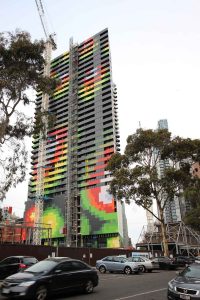Controversial, it seems as if Australian Aborigines do not allow their pictures taken for one to be on the prominent façade. It is grandiose artwork nonetheless. Compared with its other façade, is it a disturbance of the architectural integrity or the madness of ‘the dreaming’? “The Dreaming is a term used by Aborigines to describe the relations and balance between the world’s spiritual, natural, and moral elements.”
How often is it that with the advancement of technology, the grasp of our history shrinks to a minimum? Over the years, there seems to be a dispute between modernizing a city and preserving the cultural remnants of the place. There is nothing wrong with wanting to become more modern, as continuous improvement drives the economy to a more stable form. The problem, however, lies in losing the asset of a community, which is its culture. The two movements, the Preservation movement and Modernism1, exist to contradict one another for years as different architectural designs start to rise. The former fought to preserve historical architecture, whereas modernists called for new designs that would uplift the architecture industry for the years to come.
In 1919, architect Mendelsohn announced: “The goal of a new architecture: the apostles of glass worlds, the seekers for new forms of material and construction. Naturally, this era will not be brought into being by social classes in the grip of tradition.” There may be a gap between modernist architects and traditional ones. But we cannot deny that with the dawn of a new era, the representation of history is in peril. Soon enough, historical landmarks can only be seen in miniature form in museums.

Recently, Swanston Square, an apartment tower, was brought to light by ARM Architecture and developer Grocon. The thirty-one-story building bore the face of William Barak, the last traditional leader of the Ngurungaeta of the Wurundjeri-willam clan. To achieve the effect, the architects sought the consultation of the Wurundjeri people as they used the xylographic technique to reduce the image and translate it into 3D.2 This is the merging of technology and history to give people a sense of modernity without abolishing its rich heritage. On the contrary, high technology in building architectural designs can be sharpened to integrate history into our daily lives. Striking a balance between developing a city and conserving its heritage is the key to a well-developed city. Such buildings ensure that culture still holds a significant part of the public’s consciousness for future generations.
This shift in how architects create design solves the rift between traditional and modernist. Suppose more and more architects embrace the idea and use technology and new ways to preserve a nation’s heritage further. In that case, the development of cities and lifestyles will be uplifted. With this new development, we would not have to choose between futuristic designs and cultural conservation as we can achieve both.
The portrait of William Barak wraps around the southern and eastern facades of the apartment building, dreaming dots facing north and west.
© Peter Bennetts / UrbanismAU
CBD Photo © Tatjana Medvedev
Rear facade: The apartment tower stands at the northern end of the Swanston Street civic axis that runs through Melbourne’s
References:
1 “What’s the Matter with Historic Preservation? ” http://www.civicconservation.org/rethinking-preservation/
2 “About face: William Barak apartments” http://architectureau.com/articles/william-barak-apartments/